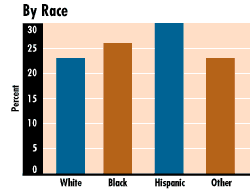
Access to Care:
Is it Improving or Declining?
Data Bulletin No. 01
Fall 1997
Cara S. Lesser, Peter J. Cunningham

![]() early one-quarter of American families report that it has become more difficult to get medical care. In a survey conducted by the Center for Studying Health System Change, 24 percent of the families interviewed said that compared with three years ago, it had become harder for them to get the care they need. Twelve percent said it had become easier, and 64 percent reported no change.
early one-quarter of American families report that it has become more difficult to get medical care. In a survey conducted by the Center for Studying Health System Change, 24 percent of the families interviewed said that compared with three years ago, it had become harder for them to get the care they need. Twelve percent said it had become easier, and 64 percent reported no change.
RESPONSES VARY BY INCOME, RACE AND AGE
![]() ow-income families were more likely to report worsening access to care. (See graphs below.) Thirty percent of families with incomes below the poverty line indicated that it has become harder to get care -- six percentage points above the average for all families. But this perception is by no means confined to the poor. Roughly one in five families with incomes equivalent to 400 percent of poverty or more reported increased difficulty in getting care. The survey also found that Hispanic families stood out as more likely than the average to report deteriorating access to care, with 30 percent doing so.
ow-income families were more likely to report worsening access to care. (See graphs below.) Thirty percent of families with incomes below the poverty line indicated that it has become harder to get care -- six percentage points above the average for all families. But this perception is by no means confined to the poor. Roughly one in five families with incomes equivalent to 400 percent of poverty or more reported increased difficulty in getting care. The survey also found that Hispanic families stood out as more likely than the average to report deteriorating access to care, with 30 percent doing so.
The one group that was dramatically less likely to experience declining access to care was the elderly. Only 11 percent of them perceived increased difficulty in getting care, while 81 percent reported no change. The fact that the elderly are almost universally covered by Medicare, and thus enjoy greater continuity and consistency in coverage, may account in part for their sense of stability.
In fact, insurance status appears to play a strong role in families’ perceptions of access to care. Forty-three percent of the families that were uninsured at the time of the survey reported worsening access to care, compared with 21 percent of the families with private insurance.
PERCEPTION THAT ACCESS IS WORSE



COMMUNITY VARIATIONS
![]() comparison of 12 randomly selected communities shows that there is some variation across markets in the perceptions of access to care. Families in Boston, Lansing and Syracuse were less likely to report that it is becoming harder to get care, while families in Miami were more likely to do so.
comparison of 12 randomly selected communities shows that there is some variation across markets in the perceptions of access to care. Families in Boston, Lansing and Syracuse were less likely to report that it is becoming harder to get care, while families in Miami were more likely to do so.
Additional study is needed to identify and quantify the factors that underlie perceptions of changes in access and explain variations across communities and demographic categories. In its ongoing efforts to track changes in the health care system and their impact on people, the Center will be able to analyze these factors alongside more objective measures of changes in access. Future iterations of the household survey will enable the Center to measure shifts over time in the perceptions of American families about their access to care.
|
IS WORSE BY COMMUNITY | Site | Access Getting Worse |
| Boston | |
| Cleveland | |
| Greenville, S.C. | |
| Indianapolis | |
| Lansing | |
| Little Rock | |
| Miami | |
| Newark, N.J. | |
| Orange County, Calif. | |
| Phoenix | |
| Seattle | |
| Syracuse | |
| Metropolitan areas over 200,000 pop. | |
| United States | |
|
*Site value is significantly different from mean for metropolitan areas over 200,000 population. Community Tracking Study, 1997 |
|
This Data Bulletin presents preliminary findings from the Household Survey, a nationally representative telephone survey of the civilian, non-institutionalized population conducted 1996 and 1997 as part of the Community Tracking Study. The survey included 43,771 persons in 23,554 families. All comparisons and differences described in the text are statistically significant at the p<0.05 level.